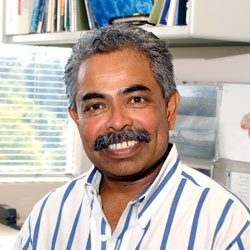| |
| |
| James T. Russell, D.V.M., Senior Investigator |
 |
Dr. Russell received his D.V.M. in 1966 from Madras Veterinary College, and a M.S. in Pharmacology from the Postgraduate Institute of Medical Education and Research, India, in 1971. He obtained his Ph.D. in Physiology from the University of Copenhagen in 1975, and joined Dr. Harold Gainer in the NICHD for postdoctoral work. His Graduate and postdoctoral work focused on the biosynthesis and secretion of oxytocin and vasopressin by the magnocellular neurosecretory system. Dr. Russell became an Investigator within NICHD in 1984 and heads the Section on Cell Biology and Signal Transduction. His laboratory explores cellular and molecular aspects of signaling in glia in response to neural activity.
|

|
Staff:
Research Interests:
This Section investigates glial cell signals associated with neural activity in the central and peripheral nervous systems. Glial cells monitor and respond to neural activity by conditioning the extacellular milieu, signaling within glial cell networks as well as by sending signals back to neurons. These glial cell signaling occurs in the form of propagated Ca2+ waves that spread over long distances or in highly localized discrete microdomains. One of the objectives of the Russell lab is to understand the processes that support temporal and spatial characteristics of Ca2+ signals within cells and between cells. A second objective is to understand the precise nature of neural activity dependent glial cell signals and the consequence of such signals to nervous system function.
In previous work on astrocytes and oligodendrocyte progenitors (OP cells) we identified the elementary Ca2+ release sites that served as regenerative signal propagation sites that supported both highly localized Ca2+ signals and long distance propagation of signals. The Russell lab characterized these specialized Ca2+ release sites and identified their organization as signaling rafts that contain the required macromolecular protein components that are tethered together by molecular scaffolds. This organization was shown to be essential for the propagation of cellular Ca2+ signals.
The long-term goal of the lab is to understand the nature of communication between neurons and glial cells in both the central and peripheral nervous systems. Towards this end we have developed transgenic animals that express a genetically encoded fluorescent Ca2+ indicator protein discretely in astrocytes and Schwann cells. Current work involves the use of neural tissue and intact mice to record activity dependent glial cell Ca2+ signals in astrocytes and Schwann cells during normal function and pathological states.
|
Selected Recent Publications:
Toews, J. C., Schram, V., Weerth, S., H., Mignery, G. A., and Russell, J. T.: (2006) Signaling proteins in the axoglial apparatus of sciatic nerve nodes of Ranvier, Glia 55, 202-213.
Weerth, S. H., Holtzclaw, L. A., and Russell, J. T.: (2006) Signaling proteins in raft-like microdomains are essential for Ca2+ wave propagation in glial cells, Cell Calcium 45, 155-167.
Holtzclaw, L. A., Pandhit, S., Bare, D. J., Mignery G. A., and Russell, J. T.: (2002) Astrocytes in adult rat brain express type 2 inositol 1,4,5-trisphosphate receptors., Glia - 39, 69-84.
Full Text/Abstract
Haak LL, Song LS, Molinski TF, Pessah IN, Cheng H, Russell JT. (2001) Sparks and puffs in oligodendrocyte progenitors: cross talk between ryanodine receptors and inositol trisphosphate receptors., J. Neurosci. 21, 3860 -3870.
Full Text/Abstract
Li, Y., Holtzclaw, L. A., and Russell, J. T.: (2001) Muller cell Ca2+ waves evoked by purinergic receptor agonists in slices of rat retina. , J. Neurophysiol. 85, 986 - 994.
All Selected Publications
Contact Information:
Dr. James T. Russell
Cell Biology and Signal Trasduction Section
Laboratory of Cellular and Synaptic Neurophysiology, NICHD
Building 49, Room 5A-22
49 Convent Drive, MSC 4480
Bethesda, MD 20892-4480
Telephone: (301) 496-5493 (office),
(301) 496-9939 (fax)
Email: james@helix.nih.gov
|
|















